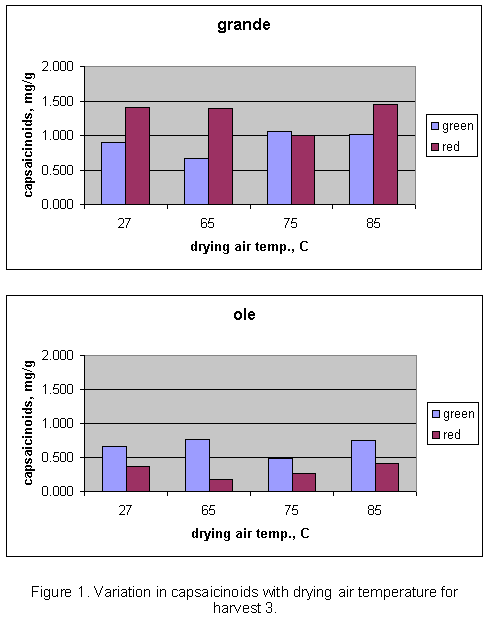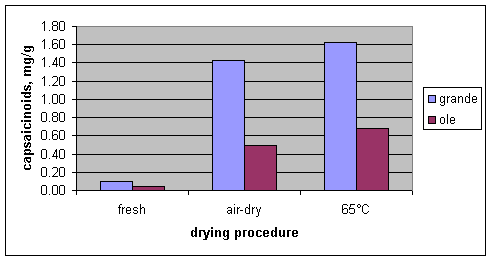Effects of Drying Procedure, Cultivar, and Harvest
Number on Capsaicin Levels in Dried Jalapeño Peppers
L. O.
Pordesimo, H. Li, B. B. Reddick, L. F. Habera, J. H. Lee
Introduction
An issue that needs to be addressed is how to
harvest and process peppers in order to obtain the highest capsaicin extraction
for use in non-food applications. This
study was undertaken to investigate this issue using jalapeño peppers as the
test material. The objective of
this study was to investigate the effects of cultivar, fruit color, harvest
sequence, and drying parameters (pod physical condition, drying air temperature)
on the levels of capsaicin in jalapeño peppers.
Results and Discussion
Observations on the jalapeño peppers planted
in 2000 in East Tennessee revealed information pertinent to processing the
peppers for non-food uses. The
greatest harvest weight of pods occurred just after the first harvest of the
season. The concentration of total
capsaicinoids in fresh jalapeño peppers did not significantly change over
progressive harvests and that there was no difference in total capsaicinoid
concentration in green or red fresh peppers.
These findings indicate that there is no need to sort fresh peppers in
order to optimize processing.
Drying temperatures tested ranging from ambient (~27°C) to 85°C did not affect the concentration of total capsaicinoids in dried jalapeño peppers (Fig. 1). It is likely that higher temperatures could be used without affecting capsaicin levels; however, this maximum temperature needs to be determined. Physical condition of the peppers when dried (whole or cut) did not affect capsaicinoids concentration with the temperature range tested. Drying effectively concentrated capsaicinoids in the dried product by almost fifteen times the level in fresh peppers (Fig. 2). If drying is to be part of any extraction process then fast drying can be accomplished to reduce costs by using higher temperatures (within limits) and slicing the peppers for enhanced moisture transfer rates. If slicing is to be accomplished, care should be given to retaining the pepper seeds


Figure 2. Effect of cultivar and drying procedure on capsaicinoids